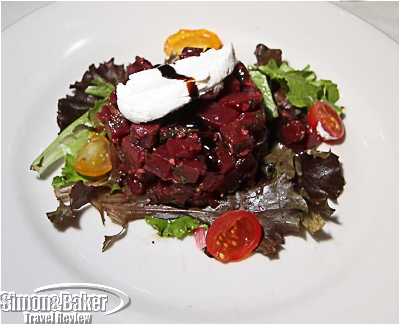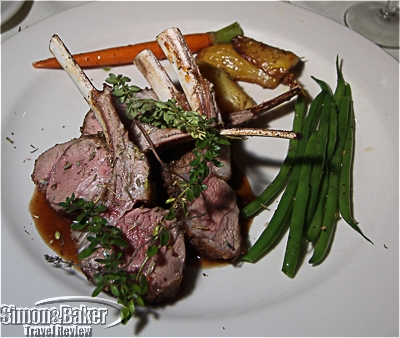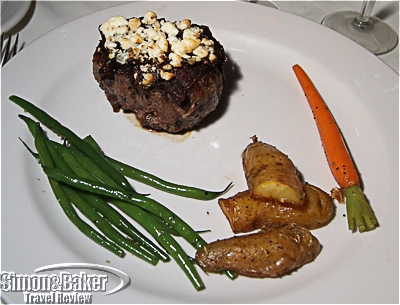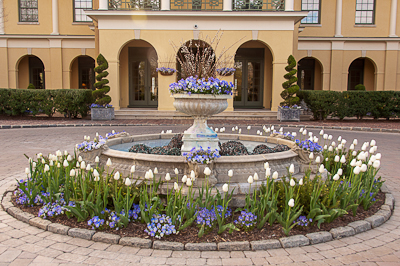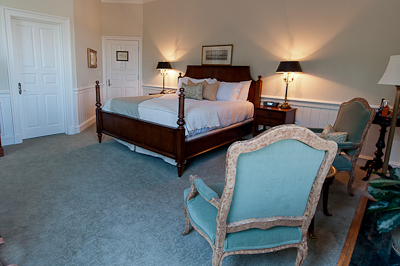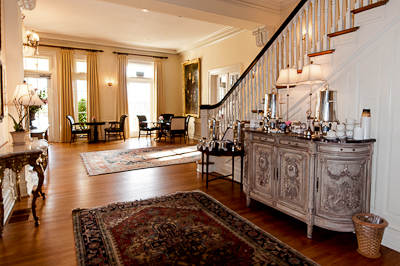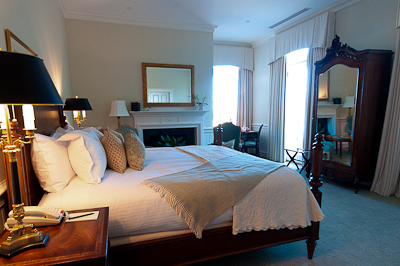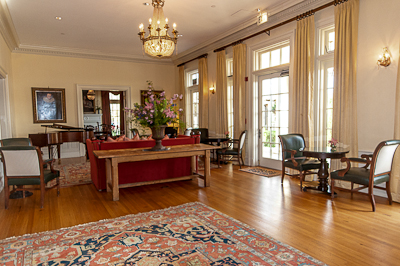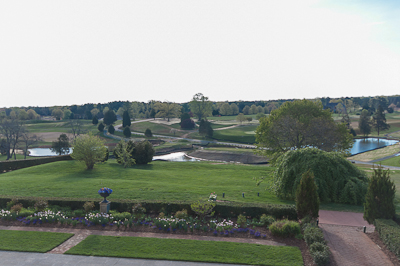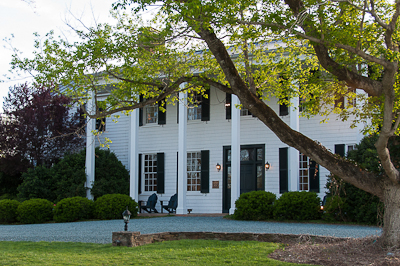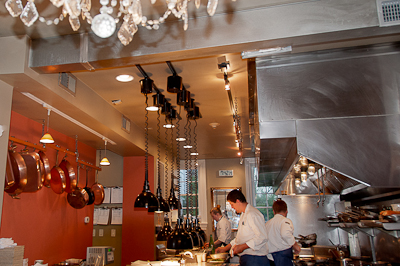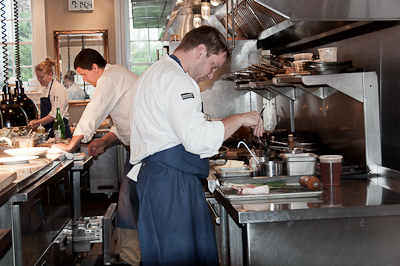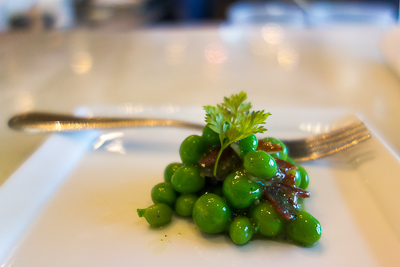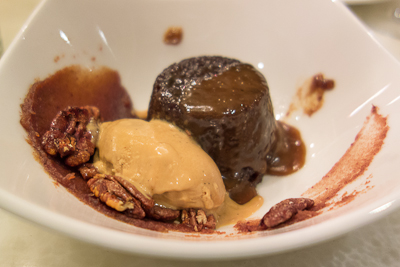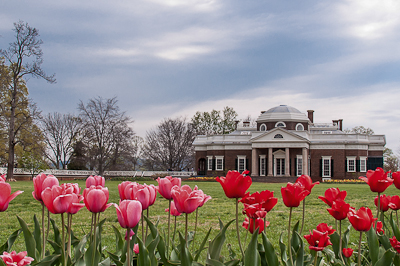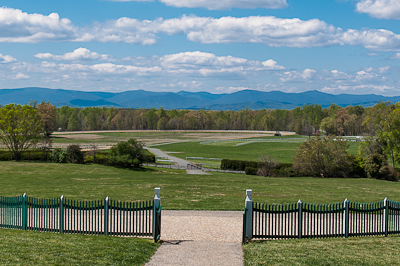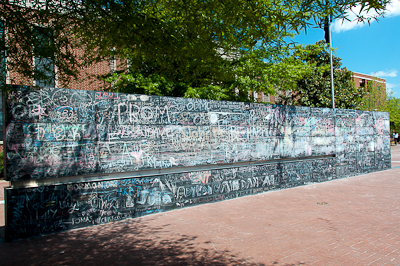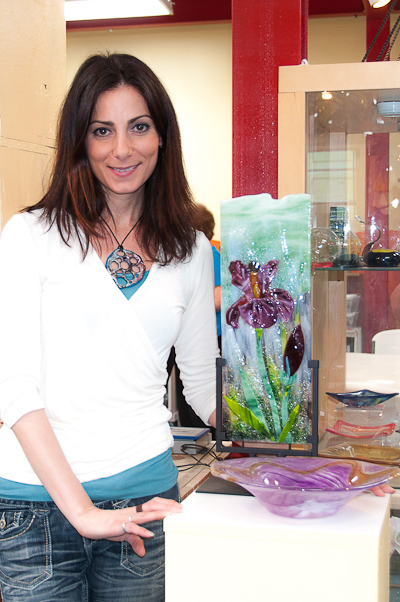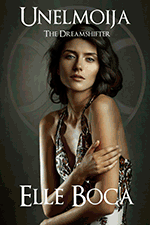Luxury Travel Review

A pleasant French style dinner in Lincolnville, Maine
By Elena del Valle
Photos by Gary Cox
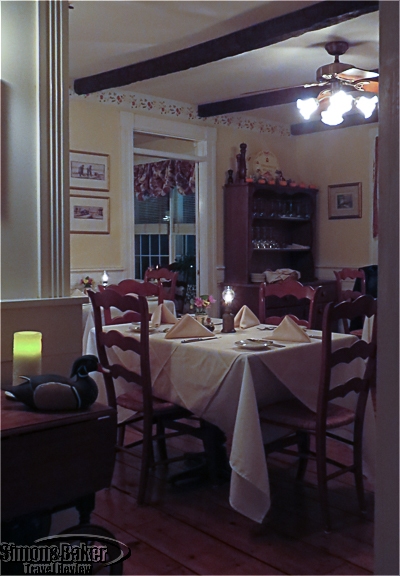
The restaurant in the Youngtown Inn
We arrived hungry at the Youngtown Inn and Restaurant in Lincolnville, Maine, after a day of driving and tourist activities with little time for lunch. Instead of driving the six miles from our nearby inn we opted for a taxi. Fortunately, it was early when we asked if the restaurant was near enough to walk. A smiling front desk staff person indicated it would be better to drive or rely on a transport service as it was several miles away down dark roads. Advance planning was necessary as it required 25 minutes before a taxi made its way to Linconlville Beach, where we were staying, from its base of operations in Rockport. It was the only taxi service available, the staff woman explained.
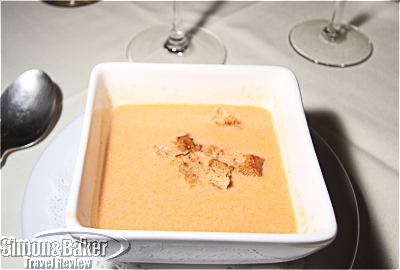
The lobster bisque
As the taxi van negotiated the dark residential roads and our tiredness sunk in we were glad of our decision. As we entered the restaurant, located within a classic 1810 farmhouse turned into a cozy four room inn, a distracted middle aged woman welcomed us, led us to our table and handed us menus. We explained that we needed a taxi and she offered to call the service when our dessert arrived. As the evening wore on her timing estimate proved to be spot on. Moments later, another personable woman arrived to announce the daily specials and bring us water. Although it was a weekend evening we were among few guests at the restaurant because of a nearby special event.
Our beet salad (click to enlarge)
The arugula salad was garnished with a flower (click to enlarge)
While the set menu was well priced, the chef’s beef and lamb specialties were on only offer in the a la carte menu so we chose that one. There were two types of bread, whole wheat and sour dough. For starters we ordered Lobster Bisque with Sherry made with fresh lobster chunks, one beet salad and one arugula salad. For mains we had Pan Seared Black Angus Filet Mignon, Caramelized Onions, Roquefort and Roast Rack of Imported Lamb with Herbs de Provence (a favorite) both of which were well prepared. They were served with green beans, carrots and potatoes. Relying on our server’s advice we ordered a 2010 Billerond Saint Emilion to accompany our dinner. It was a good match for the meal, stout enough for the red meats yet well rounded and with a smooth finish.
The lamb was moist and tasty (click to enlarge)
The filet mignon with the pepper sauce removed
Although the menu description of my filet mignon said nothing about pepper nor did the server mention it when I placed my order, the meat was sitting atop and covered in a thick black pepper sauce. After I raised the issue, the server took it back to the kitchen where they removed the sauce. She brought it back quickly and it was still hot, but the pepper flavor had penetrated the meat, making it difficult to enjoy my dish or taste the Roquefort cheese.
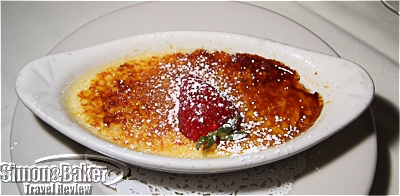
The creme brulee
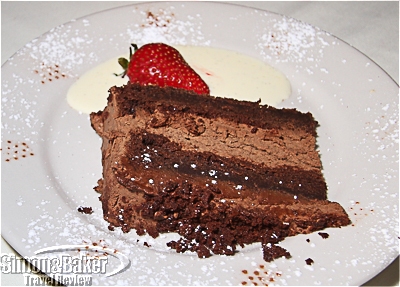
The chocolate truffle cake
For dessert we had Tahitian bean Creme Brulee and Chocolate Truffle Cake. While the thin slice of cake didn’t look especially appetizing it had a rich chocolate flavor. Dinner was pleasant. The Youngtown Inn and Restaurant, 581 Youngtown Road, Lincolnville, Maine 04849, +1 207-763-4290, info@youngtowninn.com
Forgotten Italianate villa back to life as world class Virginia boutique hotel
Article and photos by Josette King
The formal arched central entrance of Keswick Hall
It is not unusual for friends who know that I am “always running off somewhere” to ask about my personal “short list” of favorite properties around the world; and be surprised that the list is quite short, of properties so exceptional in their location, surrounding, facilities, accommodations and service that I would gladly fly half way around the world to enjoy them again. On my recent visit to Charlottesville, Virginia I had the pleasure of adding one entry to my list, Keswick Hall.
The infinity swimming pool acted as a reflecting pool for the north facade of the villa
The elegant Italianate mansion located on 600 acres (243 hectares) of pristine countryside at the eastern edge of the city had the feel of a grand English country estate. As I drove around the circular driveway to the formal triple archway of the central entrance, I fleetingly wondered whether the walking shoes and jeans in which I had roamed all day from area wineries to remote artist studios were appropriate for the occasion. But already, the doorman was making me welcome like a long expected friend of the family. My luggage was out the trunk and my dusty rented car whisked away by the time I stepped through the open door into my “great uncle’s country mansion.”
My room was a welcoming retreat of understated elegance
It was just as Sir Bernard Ashley intended when in 1991 he set out to transform the decaying Italianate Villa Crawford into a world class property where guests would feel they were staying at a private manor house. Three years and a $25 million major restoration and expansion effort later, he had created Keswick Hall.
The historic North Wing had reclaimed its original opulence
In the central grand entrance hall, mellow oriental rugs created intimate spaces for clusters of inviting sofas, armchairs and antique accents furniture. Fresh flowers, in seemingly simple arrangement hinted at having been brought from the garden on a whim by an artistically minded lady of the house.
An antique mirrored armoire was a focal point of my room
In spite of its vast proportions, the room had a lived in feel, as though it had organically developed to its current gracious state through generations of residents. I had to remind myself to look for the reception area. It was there, an inconspicuous desk in the corner nearest to the entrance, as was the concierge desk, in the opposing corner of the hall. Both were staffed with knowledgeable and attentive hosts who appeared ready to assist with even the smallest of wishes. This was the norm for any staff member with whom I came in contact.
The North Wing sitting room
My own accommodations were equally welcoming, a large light filled room decorated in a relaxing neutral palette and a mix of antiques and period inspired furniture, and a French door that opened onto a large corner terrace with views of the garden and the manicured vistas of the golf course. Fossett’s, the property’s award winning restaurant, was remarkable not only for the quality of its classic continental cuisine with Virginia flair, but for it panoramic views of the estate’s rolling hills and the Blue Ridge Mountains beyond.
The lower terrace of the mansion reached out the rolling lawns at the rear of the estate
In addition to its flawless hospitably, Keswick Hall offered activities to indulge the most varied tastes, from the billiard room restored in the original Villa Crawford, now the Historic North Wing of the mansion, to an in-house spa, a croquet pitch overlooking the Southwest Mountains, spectacular 18 hole golf course, nature walk and bird watching trails, aquatic center and tennis courts. It even had its own courtside vineyard. But for me, the ultimate luxury was the Horizon Pool, the adults only, heated saltwater infinity pool that reflected the north façade of the mansion. Best of all, it was open around the clock.
Peak Design straps made it easy to carry cameras outdoors
Article and photos by Gary Cox

Using the Clutch I held the camera in position, ready to shoot during a cliff side hike
I had a chance recently to field test the Slide and Clutch camera straps from Peak Design. Prior to using the new straps, the Canon EOS-7D SLR I use when traveling sported the manufacturer supplied neck strap and I rarely gave it a second thought. It was a bit annoying when using the tripod to have the strap hanging off the camera, but it was too much trouble to remove or even adjust the old fashioned length clips, except in extreme circumstances.
When walking around to photograph a property or a destination, the strap provided a measure of safety to avoid dropping the camera, but I had to be alert and hold the camera in my hands to prevent the lens or body from smacking against something and being damaged. When hiking, I usually place the camera into a padded pack or case. With the camera securely packed away, I noticed a tendency to only pull it out and use it at particularly special spots, sometimes passing up shots that I would regret later. Holding the camera with the Clutch make it more likely for me to take those spontaneous photos, and for that I was glad.
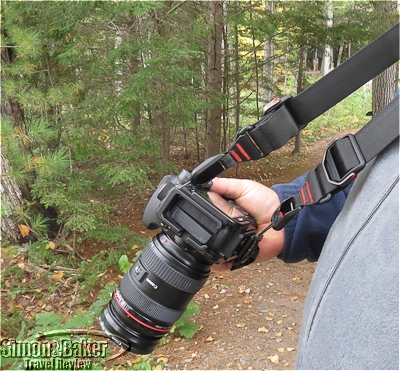
The Slide shifted the weight of the camera away from my hand during long walks
The Peak Design straps offered some noteworthy innovations that made it easier to carry the camera securely and be ready to take a shot at anytime. The Clutch was a surprising pleasure to use. It allowed me to hold the body securely with my hand positioned to shoot. I adjusted my grip using its small strap to fit my hand snugly in place. Adding the Slide strap made it easy to carry the camera along on a hike, ready to shoot at all times, while shifting the weight to my neck. The Slide strap was sturdy, made from the same material as vehicle seat belts, and reinforced with padding in the center. It was simple to adjust the length of the Slide by opening the clips, moving the strap through them and locking it securely.

The quick release clips made length adjustments easy
The Anchor Link quick-connectors attached the Slide to the camera body and the bottom of the Clutch. The top of the Clutch attached directly to the camera, with a quick release spring to prevent accidental release. A plate provided with each strap could be mounted onto the bottom of the camera body using a standard screw. Multiple quick-connectors could then be attached to the plate. I prefer to use my custom fit plate from Kirk Photo on the camera body because it allows me to turn the camera sideways on the tripod and provides a stable surface to set the camera onto (provided the attached lens is not too heavy). Fortunately, my Kirk Photo plate includes a nice little slot to mount the quick-connectors. Aesthetically speaking, I prefer the sleek lines of my single plate which is custom shaped to the Canon body and will not twist or turn when I adjust the camera on the ball head.

The plate supplied with the straps provided four mount points

My Kirk Photo custom plate also provided a useful mounting point
The quick-connectors allowed rapid attachment and removal of the straps, perhaps my favorite feature. They gave the set-up solid feedback, and could support 150 pounds each, according to the manufacturer. The interlocking of the lozenge shaped anchor into the clip provided easy visual confirmation that the strap was secure. With a few extra Anchor Link quick-connectors on hand, my spare camera body can be ready for action quickly. All it requires is that I move the straps. I liked being able to remove the strap when placing the camera onto the tripod, eliminating one potential tipping hazard. I never found it necessary to detach the Clutch, other than when I was playing with different configurations of the Sling, a few of which used the top attachment point on the camera body.

The Anchor Link quick-connectors attached the straps to the camera securely
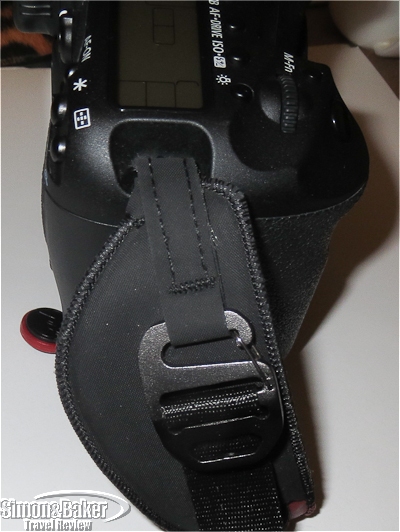
It was a matter of moments to set up the Clutch attachment to the camera
Peak Design took the mundane camera strap and updated every aspect of it. They improved the method of attachment, how it is adjusted, the options for carrying the camera and enhanced my overall experience as a photographer. I plan to continue to use those straps as part of my ongoing equipment configuration. The Peak Design mission of enabling “photographers, adventurers and outdoors enthusiasts to better capture the beautiful world around them” appealed to me. I was pleased to discover the products fulfilled this mission for my purposes. Peak Design, 2325 3rd Street Suite 410, San Francisco, California 94107, http://peakdesignltd.com
+1 312.203.8427, info@peakdesign.com.
Inspired Charlottesville chef reinvents classic cuisine for twenty first century
Article and photos by Josette King
The restaurant was located on the first floor of the Clifton Inn
During my recent visit to Charlottesville, Virginia I had the pleasure to dine at the Clifton Inn Restaurant. My reservation, made ahead by a local friend, indicated that it was for the Chef’s Counter. I didn’t realize the extent of my good fortune until I was escorted through the dining room, straight to the kitchen. As the daughter of a French chef, I have appreciated since childhood that it is a singular privilege to be invited into the inner sanctum. And that night, I was the chosen one.
I was momentarily perplexed by the long row of copper pans, much too perfectly shined to have seen recent service, lined against a coral accent wall, and the gilded mirror at the far end of the room, strategically placed to reflect the crystal chandelier that hung over the pale polished concrete counter. But then I hoisted myself onto a comfortable bar chair, and across the countertop, had a panoramic view of the kitchen.
The Chef’s Counter provided a front row view of the action in the kitchen
It was equipped with the latest in high end professional equipment and had a traffic pattern designed for maximum efficiency. It clearly meant business. As did Tucker Yoder, the executive chef, and his capable team.
Everyone was calm, focused on the task of the moment, every gesture precise as they created one remarkable dish after another. And yet they were sufficiently relaxed to engage in conversation with me about anything from the unusual pairings of textures and flavors on my plate or the culinary journey that had led them to the Clifton to the ethos of the farm to table movement.
Chef Yoder, sous chef Jared Adams and pastry chef Kristen Johnson focused on their creations
It was a creative group of professionals who, under the guidance of Chef Yoder, delighted in pushing the boundaries of classic cuisine, and experimenting with ingredients and techniques to bring gastronomy into the 21 century, except when timeless tradition still delivered the best results. They churned their own butter, made sourdough bread from a three year old starter and kept a kitchen garden (right outside the kitchen door).
At the Chef’s Counter, guests had the option to choose from the restaurant’s menu or the tasting menu. I opted for the latter and what followed was two hours of bite size delights and discoveries.
Ham and pea salad with chervil
“What is this?” I had to ask of the crisp leaf shaped wafer under the creamy dollop of pureed apple and fennel of my amuse bouche. Jared Adams, sous chef, who was working nearest to me at the moment, volunteered that it was dehydrated ramp, a sort of local wild leek. And by the way, they foraged it.
Several dishes later came the field greens salad, fresh from the garden; so fresh there was a spoonful of garden dirt on the plate. That time Kristen Johnson, pastry chef, answered, “just black cocoa powder, butter and sugar, lightly baked then finely crumbled.”
Sticky pudding with date puree, candied pecans and caramel ice cream
We have come a long way since garlic croutons. If pressed to identify a favorite dish, a hard decision, I probably would have singled out the succulent grit encrusted oysters with their garnish of sautéed wild mushroom, served over pureed apples with brown butter. But that’s because I hadn’t yet factored in dessert. I had challenged Kristen to surprise me with “her most Virginian dessert.” That turned out to be a divine sticky pudding with date puree, candied pecans and caramel ice cream. Even after so many dishes (I had lost count long before the end of the meal), I cleaned my plate. At Chef Yoder’s Counter, excess was a wonderful thing.
Conservationist and ornithologist explore Caribbean wildlife
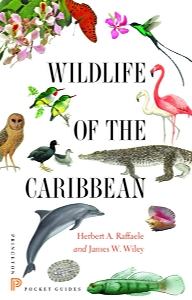
Wildlife of the Caribbean
Photos: Princeton University Press
In Wildlife of the Caribbean (Princeton University Press, $19.95) a 304-page softcover book published this year, Herbert A. Raffaele, a wildlife conservationist, and James W. Wiley, a researcher of ornithology, explore nature in The Bahamas and the Caribbean: Cayman Islands, Greater Antilles, Lesser Antilles, and Virgin Islands. Color tabs identify each section for easy reference. An introductory section addresses the region, its geography and conditions. The remainder of the book is divided by type of grouping.
The book includes 600 color images of 451 species of island flora and fauna. The authors focus on the most widespread and visible plants, terrestrial mammals, birds, terrestrial reptiles, amphibians, terrestrial invertebrates, marine mammals, marine reptiles, marine fish, and marine plants and invertebrates, and seashells. The bird section is by far the largest. There is information about the identification, status and distribution of the plants and animals of the region.

Herbert Raffaele, coauthor, Wildlife of the Caribbean
Raffaele directed wildlife conservation at the Department of Natural Resources in Puerto Rico, and was chief of Latin American and Caribbean programs for the United States Fish and Wildlife Service. Since 1972, Wiley has worked in ornithological research in the Caribbean. The two are coauthors of Birds of the West Indies.
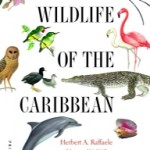
Click to buy Wildlife of the Caribbean
Rich history, boutique wineries and vibrant cultural life made Charlottesville enjoyable destination
Article and photos by Josette King
The rear of Monticello overlooked vast expanses of lawns and flower borders
This was my first visit to Charlottesville, Virginia, a small historic city with a big reputation. I admit I approached it with a degree of skepticism. Everyone I knew who had ever visited had come back smitten and daydreaming about settling there. Surely, no place could be that idyllic? Charlottesville was.
Montpelier offered stunning views of the Blue Ridge Mountains
Although a mere 115 miles (185 kilometers) from Washington, D.C. and 70 miles (110 kilometers) from Richmond, this small Central Virginia city nestled in the picturesque rural foothills of the Blue Ridge Mountains had, in spite of its popularity, retained the charm and tranquil pace of earlier times. Its once Main Street was now the Downtown Mall, an eight block tree shaded pedestrian walkway lined with restored historic buildings. There, antique shops, art galleries and all manner of fashion boutiques mingled with café terraces, restaurants, pubs and several movie and live performance theaters. A favorite spot for tourists as well as local people had a Freedom of Expression Wall where passersby could pen (in chalk) what was on their mind, which I was told included the occasional marriage proposal. The wall was erased each night to give others an opportunity to have their say.
Passersby were welcome to scroll their thoughts on the Freedom of Expression Wall
Charlottesville has conserved to this day the enduring mark imparted upon it two centuries ago by its most illustrious citizen, Thomas Jefferson. In addition to his Monticello home, he founded and designed the University of Virginia. Both of the neoclassical (or Jeffersonian style) masterpieces are now UNESCO World Heritage Sites. Today, Monticello attracts half a million visitors annually and the University of Virginia, with its yearly enrollment of over 23,000 students, contributes significantly to the cultural vitality of the area.
Jefferson also made a significant impact on the landscape of the area, albeit posthumously, when he attempted to establish vineyards on land adjoining Monticello, only to have his efforts thwarted by the start of the Revolutionary War in 1774. In the latter part of the 20 century, a handful of determined growers were inspired to revisit his vision to develop the Central Virginia vineyards.
The tasting room at Jefferson Vineyards Winery
Today, Virginia has over 2,000 acres (810 hectares) of vineyards, half of them around Charlottesville. Almost 30 of the wineries form the Monticello Wine Trail and welcome visitors in their tasting rooms. A well mapped itinerary took me along some of the loveliest back roads of the greater Charlottesville area. One of the oldest, Jefferson Vineyards, was within a stone’s throw of Monticello, on the very land where Jefferson made his own wine growing attempt.
In addition to Thomas Jefferson, the Charlottesville area was also home to two more of America’s Founding Fathers, James Monroe and James Madison. All three became President of the United States and their respective homes Monticello, Ash Lawn Highland and Montpelier were open to tourists. I combined their visit, in an itinerary known as the Presidents Trail, with that of nearby wineries. Along the way, I soon discovered that the bucolic setting had drawn a large number of talented artists and craftspeople, whose studios and galleries made for an enjoyable visit as well.
Glass artist Cara DiMassimo with some of her recent creations
With its charming rural environment, rich history, vibrant artistic life, inviting vintage downtown, wineries and more than a few notable restaurants to boot, I could see how Charlottesville could be an enjoyable place to live. It was an exceptional place to visit.

